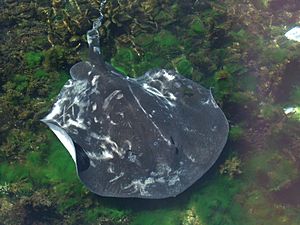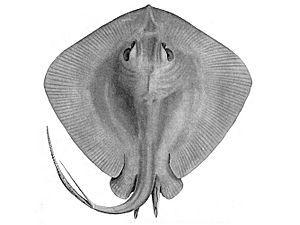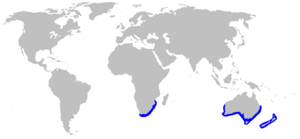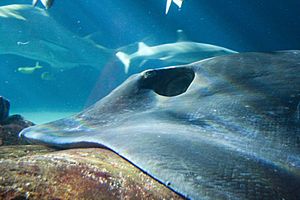Short-tail stingray facts for kids
Quick facts for kids Short-tail stingray |
|
|---|---|
 |
|
 |
|
| Conservation status | |
| Scientific classification | |
| Genus: |
Bathytoshia
|
| Species: |
brevicaudata
|
 |
|
| Range of the short-tail stingray | |
| Synonyms | |
|
|
The short-tail stingray (Bathytoshia brevicaudata), also called the smooth stingray, is a large type of stingray. It belongs to the Dasyatidae family. You can find it off the coast of southern Africa, usually deep underwater (about 180 to 480 meters or 590 to 1,570 feet). It also lives off southern Australia and New Zealand, from shallow coastal areas to depths of 156 meters (512 feet).
This stingray mostly lives on the ocean floor. It can be found in many places, like estuaries (where rivers meet the sea) and reefs. However, it often swims into open water too. It is the biggest stingray in the world! This heavy ray can grow to be over 2.1 meters (6.9 feet) wide and weigh up to 350 kilograms (770 pounds). Its body is shaped like a diamond and is usually plain in color, like dark gray or black. Some have rows of white spots on their "wings." Unlike some other rays, it doesn't have rough scales (called dermal denticles) on its body, even when it's an adult. It also has white pores near its head. Its tail is usually shorter than its body and is thick at the base. It has large bumps and a row of big thorns in front of its stinging spine.
The short-tail stingray eats invertebrates (like crabs and worms) and bony fishes. This includes animals that burrow in the sand and those that swim in the middle of the water. It usually stays in a small area and doesn't travel long distances. During winter, it prefers deeper waters. Large groups of these rays gather at certain times of the year. For example, they gather in the summer at the Poor Knights Islands off New Zealand. Both mating and giving birth happen in these groups.
This species gives birth to live young. The baby rays grow inside the mother and are fed a special "uterine milk." A mother can have six to 10 babies at a time, but sometimes even 15! The short-tail stingray is not usually aggressive. However, its long, venomous sting can cause a very serious injury. People often catch these rays by accident while fishing. Most of the time, they survive and are released. Because its numbers seem healthy, the International Union for Conservation of Nature (IUCN) lists it as a species of least concern.
Contents
What is a Short-Tail Stingray?
The short-tail stingray was first described by Frederick Hutton in 1875. He was a scientist and worked at the Otago Museum in New Zealand. He studied a female stingray that was 1.2 meters (3.9 feet) wide. He named it Trygon brevicaudata. The name comes from Latin words: brevis means "short" and cauda means "tail."
For a long time, this ray was grouped with other Dasyatis stingrays. But recent studies in 2016 showed it should be in its own group called Bathytoshia. Other names for this ray include giant black ray, giant stingray, and smooth short-tailed stingray. It is closely related to the pitted stingray (Dasyatis matsubarai), which looks similar but is smaller.
How to Identify a Short-Tail Stingray
The short-tail stingray is a very strong and smooth ray. Its body, called a pectoral fin disc, is shaped like a diamond and is a bit wider than it is long. The front edges of its body are gently curved and meet at a blunt, wide snout. Its eyes are small, and right behind them are much larger breathing holes called spiracles.
Its mouth is not very big and has a curved lower jaw. It has small, blunt teeth arranged in a flat pattern, like a checkerboard. There are about 45–55 rows of teeth in each jaw. Its pelvic fins are somewhat large and rounded.
The tail is usually shorter than the body. It has one, or sometimes two, stinging spines with jagged edges on top. These spines are about halfway down the tail. The tail is wide and flat near the body, then gets thinner quickly after the sting. It has a clear fin-like fold underneath and a small ridge on top. Only the tail has small, rough scales (dermal denticles). Adult rays have a row of large, spear-like thorns or flat bumps along the middle of the tail in front of the sting. They also have smaller, cone-shaped thorns behind the sting, all the way to the tip.
The top of the ray is grayish-brown. It gets darker towards the tip of the tail and above the eyes. There is a line of white pores on each side of its head. The underside of the ray is whitish. Some short-tail stingrays have been seen that are albino, meaning they are completely white. This ray is the largest stingray species. It can be at least 2.1 meters (6.9 feet) wide, 4.3 meters (14 feet) long, and weigh 350 kilograms (770 pounds). Some people in New Zealand have even reported seeing individuals almost 3 meters (9.8 feet) wide! Female rays that are ready to mate are about one-third larger than males.
Where Short-Tail Stingrays Live
The short-tail stingray is common in the cooler waters of the Southern Hemisphere. Off southern Africa, it lives from Cape Town in South Africa to the Zambezi River in Mozambique. Along the southern coast of Australia, it is found from Shark Bay in Western Australia to Maroochydore in Queensland, including Tasmania. In New Zealand, it lives off North Island and the Chatham Islands. It is rarely seen off South Island and the Kermadec Islands.
In southern Africa, this stingray is rare in shallow water. It is usually found over deep ocean banks, 180 to 480 meters (590 to 1,570 feet) deep. However, off Australia and New Zealand, it lives from the very shallow intertidal zone to depths of 156 meters (512 feet). In Australia and New Zealand, these rays are most common in shallow waters during the summer. A study in New Zealand showed that two rays moved to deeper waters in winter. However, they did not travel long distances.
The short-tail stingray mainly lives on the bottom of the ocean. It lives in many different places, including brackish estuaries (water that is a mix of fresh and salt), calm bays, sandy areas, rocky reefs, and the edge of the continental shelf. But it also often swims up into the middle of the water.
Short-Tail Stingray Behavior and Diet
The short-tail stingray usually moves slowly. But it can suddenly burst into speed, flapping its fins so hard that it makes a loud "bang" sound in the water. This happens because the water is pushed faster than it can react, causing a drop in pressure.
These rays are known to gather in large groups at certain times of the year. A famous example is every summer (January to April) at the Poor Knights Islands off New Zealand. They often gather under rocky archways. In some places, they move into very shallow water when the tide comes in. Individual rays tend to stay in a small area, usually within 25 kilometers (16 miles) of their home. Studies have shown that they can sense magnetic fields. They might use this ability to help them navigate in nature.
The short-tail stingray looks for food both during the day and at night. It mostly eats bony fishes and invertebrates that live on the bottom, such as molluscs (like clams) and crustaceans (like crabs). It has a special sensing system on its underside. This system helps it find tiny water movements made by buried clams or worms. It then sucks them out of the sand. Any extra water is pushed out through its spiracles. It also eats fish and invertebrates that live in open water. Off South Africa, these rays have been seen hunting squid eggs during mass squid spawning events.
The short-tail stingray has few predators because of its large size. Some animals that might hunt it include the copper shark, the smooth hammerhead, the great white shark, and the killer whale. When it feels threatened, it raises its tail over its back like a scorpion as a warning. Smaller fish have been seen swimming near rays to use them for cover while hunting their own prey.
Life Cycle and Reproduction
The large groups of short-tail stingrays at the Poor Knights Islands seem to be for reproduction. Both mating and giving birth have been seen there. Mating happens in the middle of the water. The strong currents flowing through the narrow archways might help the rays stay in place.
When a female is ready to mate, several males might follow her. They try to bite and hold onto her body. One or two males might be dragged by the female for hours before she agrees. The successful male flips upside down under her. He then inserts one of his claspers (male reproductive organs) into her body and waves his tail. Mating usually lasts 3–5 minutes. Females in aquariums have been seen mating with up to three different males in a row.
Like other stingrays, the short-tail stingray gives birth to live young. The baby rays grow inside the mother. At first, they get food from their yolk sac. Once that runs out, the mother feeds them a special "uterine milk." This milk is rich in proteins, lipids (fats), and mucus. Females usually give birth to six to 10 pups in the summer. Males sometimes help by gently nudging the female's belly with their snouts. Females are ready to mate again soon after giving birth. Newborn rays are about 32–36 centimeters (13–14 inches) wide.
Short-Tail Stingrays and Humans
Short-tail stingrays are often curious and not aggressive. They may even come close to humans and can be trained to be hand-fed. At Hamelin Bay in Western Australia, many short-tail stingrays, thorntail stingrays, and New Zealand eagle rays regularly gather to be hand-fed fish scraps. More and more visitors come to see this, and there is interest in making it a permanent tourist spot.
However, if a short-tail stingray is surprised or bothered, its sting can cause a very serious, even deadly, injury. The sting can be over 30 centimeters (12 inches) long. It can go through most types of footwear, even tough kevlar bootees. The sting has a special coating that contains a toxin. This toxin can cause tissue damage. The most dangerous injuries happen if the sting hits a vital organ, causes a lot of blood loss, or leads to serious infections. A startled ray can also jump out of the water and cause injuries with its tail. This species is responsible for most stingray injuries in New Zealand. Sadly, a famous wildlife expert, Steve Irwin, died from a stingray injury.
People often catch short-tail stingrays by accident when fishing. This happens with different types of fishing, including trawls, seines, longlines, and nets. Recreational fishers also catch them with hooks, spears, and harpoons. Most of the rays caught are released alive. Sometimes, fishers cut off their tails for safety. However, this practice does not seem to hurt the rays' long-term survival. Some sport fishers keep the rays for meat or fishing contests. A few are also kept in public aquariums, and they can have babies in captivity.
Because this ray survives fishing activities well and is still common, the International Union for Conservation of Nature (IUCN) has listed it as least concern. This means its population is not currently threatened. In most of New Zealand, it is against the law to fish for them for commercial purposes. In June 2018, the New Zealand Department of Conservation said the short-tail stingray is "Not Threatened."
|
See also
 In Spanish: Bathytoshia brevicaudata para niños
In Spanish: Bathytoshia brevicaudata para niños







